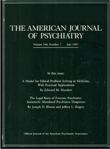TO THE EDITOR: The article by Kenneth S. Kendler, M.D., and colleagues (
1) examines the relationship among dimensions of religiosity and current psychiatric symptoms, current substance abuse, lifetime psychiatric disorders, and lifetime substance dependence and explores the stress-buffering properties of religiosity.
Subjects studied varied in their religious preference, and affiliations were ranked into five groups of decreasing conservatism. The ordering of institutional affiliations was then cross-validated with self-report measures of personal devotion and personal conservatism. The authors found that “high levels of personal devotion were associated with less of a response to the depressogenic effects of stressful life events.” However, they also reported that “neither personal conservatism.nor institutional conservatism.were associated with a significant change in sensitivity to the depressogenic effects of stressful life events.” Finally, Kendler et al. state that they found “little overall evidence for a relationship between religiosity and current psychiatric symptoms or lifetime psychopathology.”
We studied a homogeneous group of “returnees” to the Lubavitch sect of Orthodox Judaism (
2). Members of this community adhere closely to the strict interpretation of Jewish law and enjoy an intensive supportive social network. Twenty-nine subjects who were referred by a community mental health clinic were interviewed. Fifteen were in active treatment for a major affective disorder or psychosis, while 14 were receiving “supportive counseling” for adjustment disorders. Additional data were obtained by interviewing the clients' therapists. Instruments used included the Self-Image Questionnaire (
3), which explored a wide range of subjective feelings including items that pertain to adolescent turmoil and self-image, and the Personal Resources Inventory (unpublished questionnaire by P. Clayton and N.M.A. Hirschfeld), which rated behaviors reflective of social interaction patterns, job and role functioning, and use of community supports.
Information was gathered from subjects' therapists, who rated the subjects' use of defenses (flexible, neurotic, or primitive), use of ritual (flexible, somewhat rigid, or extremely rigid), adherence to religious rules (just adhering or ego-gratifying), and degree of internalization of religious values (rote, variable, or internalized).
Subjects with a DSM-III diagnosis of major mood disorder or psychosis used more primitive defenses, adhered to rules in a rote-like way, and used ritual more rigidly and with less ego gratification. Despite seemingly high levels of “personal devotion,” religiosity in these subjects did not serve as a buffer against stressful life events. Members of this group were receiving one or more public benefits, were less involved in community efforts, and were less adaptive in their household responsibilities.
For subjects in whom a major DSM-III diagnosis was not present, household income was much higher, subjects were more likely to be happily married, community involvement was greater and less need serving, and religious ritual was more flexible and ego enhancing.
Our conclusion was that subjects' ability to internalize religion and make effective use of a close community support system to buffer them against stressful life events appeared to have been influenced by genetic or environmental factors before their religious conversion.

